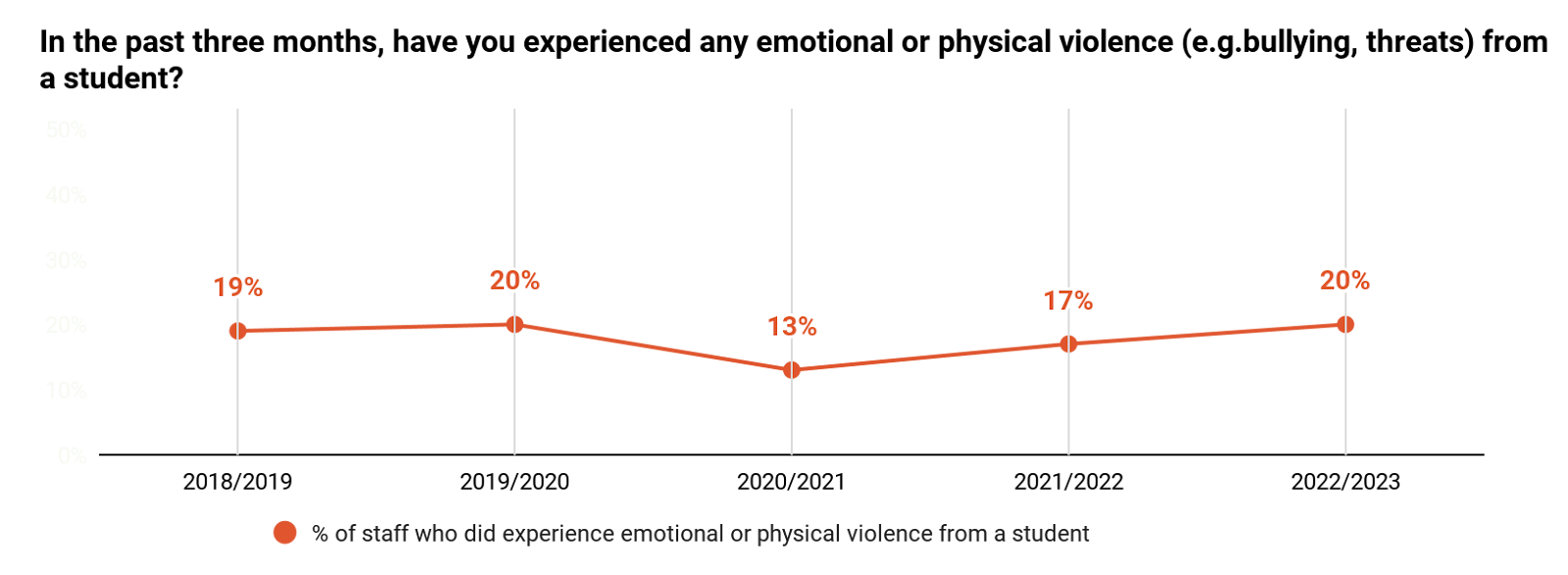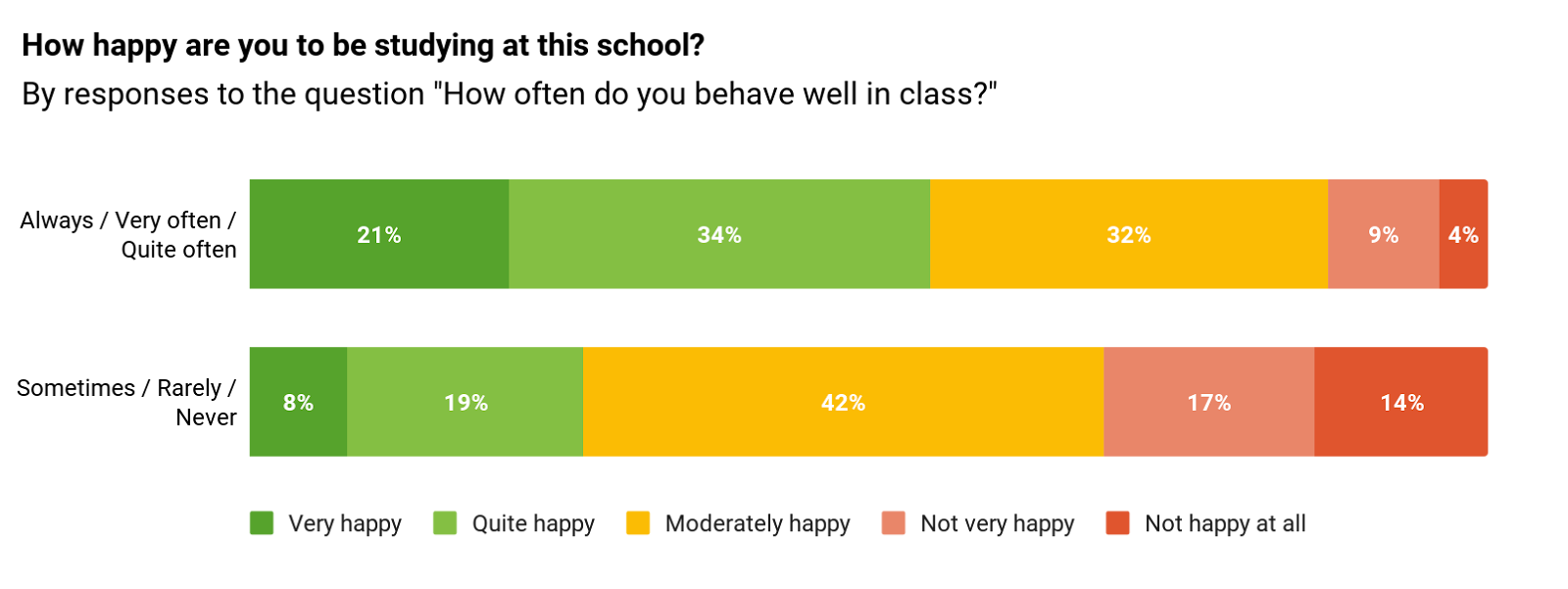20 February, 2024
5 key insights for addressing behaviour and safety challenges
Searching for the best education leadership books? Look no further! We’ve curated a list of top picks for 2024, covering school improvement, leadership tips, and more.
This blog post will explore five interesting new insights from our Behaviour and Safety: Key Trends and Challenges report. Comparing the responses from over 400,000 staff, pupils and parents from the last five years of data collection, the data in our Behaviour and Safety report explores the current educational landscape in relation to Behaviour and Safety in English Schools.
- Staff Report levels of Emotional or physical violence from a pupil back to pre-pandemic levels.
Throughout the academic year 2022/23, a startling statistic emerged as 1 in 5 members of staff reported experiencing emotional or physical violence from a pupil.

Although experiences of safety and support related to pupil behaviour improved during the pandemic, the most recent data indicates a return to, or even surpassing, pre-pandemic levels.

2. Classroom Disruption at the highest levels since the Staff experience and Wellbeing survey began.
During the COVID-19 pandemic (2020/21), while home learning was more prominent, staff reported a lower rate of work disruption due to poor pupil behaviour (25%). As schooling has returned to normal, the data highlights a year-on-year increase in the levels of disruption being reported by staff members, now higher than pre-pandemic levels.
2022/23 data shows that 37% of staff experienced their work being disrupted constantly or often, 37% sometimes experienced their work being disrupted by poor pupil behaviour, and only 26% of staff reported their work is rarely or never disrupted by poor pupil behaviour.
3. Behaviour a Key Contributor to Staff Resignation
As we saw in our Staff Retention Blog, 43% of all staff considering resigning sometimes, often or constantly in 2022/23. In responses collected between May and December 2023/24, since introducing the question “What has made you consider resigning?” into the Staff Experience and Wellbeing Survey, pupil behaviour was the 4th most frequently reported reason for considering resigning for those who are considering resigning.
4. The majority of pupils report behaving well during class.
The report revealed that most pupils (92%) believe they behave well during class, linking positive behaviour to higher wellbeing and happiness in school. Conversely, those reporting less favourable behaviour are more likely to express dissatisfaction with their school experience.
55% of pupils who reported behaving well in class “always, very often, quite often” were happy to be studying at their school, as opposed to 27% of pupils who reported behaving only “sometimes, rarely, or never.”
5. Pupils’ feelings of safety worsened year on year between 2020/2021 through 2022/2023.
Over the last three years, there has been a steady decline (-8%) in how safe pupils feel during class. Only 65% of pupils reported feeling “Very safe” or “Quite safe” in 2022/2023.
Additionally to the lower levels of perceived safety among pupils, 42% of pupils in 2022/23 reported feeling their learning was disrupted very or quite often by someone’s behaviour. Only 1 in 4 (27%) felt their learning was rarely or never disrupted.
What can you do as an educational leader…
While the increasing statistics surrounding classroom disruption, the deterioration of pupil feelings of safety, more staff considering resigning than previously recorded, and pupil behaviour is one of the top reasons they report considering resigning. This data should motivate us to look for solutions, many of which already exist.
Policy and Best practice advice from the sector
NASUWT highlight that Behaviour management strategies and policies are a crucial element of a school’s culture. They offer advice on developing behaviour management policies, and share what they believe are eight principles that underpin effective behaviour management. They highligh that the principles should be considered in conjunction with the NASUWT’s guide to Developing a Behaviour Management Policy.
The Department for Education also have a range of resources and guidance to support with behaviour in schools.
Education Endowment Foundation outline a Guidance report published in 2021, which holds valuable advice and learnings for the sector. From this report, there is a simplified recommendations poster, which has advice on proactive and reactive measures to employ in order to improve behaviour in schools.
Resources to support pupil behaviour
When it comes to physical resources that may be helpful for behaviour management Twinkl has a great range for primary settings, with reward incentives, values-based displays, and behaviour prompts for around the classroom.
Similarly TES have a wide selection of primary and secondary based resources that can offer inspiration for your own schools/classrooms.
What’s next?
If you are interested in having a closer look at Behaviour and Safety and want to understand how it impacts pupils’ educational experience:
- Run a Pupil Learning Experience and Wellbeing Survey to understand how pupils are feeling in your trust or school. Reach out to us for a demo.
- Run a Staff Experience and Wellbeing Survey to understand how staff are feeling in your trust or school. Reach out to us for a demo.
- Run a Parental Engagement Survey to understand how parents within your school community are feeling. Reach out to us for a demo.
- Read the Behaviour and Safety: Key Trends and Challenges report to learn more about the experiences of stakeholders in schools and trusts in England in relation to behaviour and safety.
- Join us for a webinar on 29.02.2024, where we’ll discuss our findings in-depth and look at how sector experts interpret the data.




